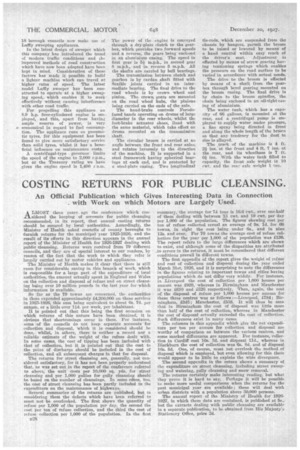COSTING RETURNS FOR PUBLIC CLEANSING.
Page 46

If you've noticed an error in this article please click here to report it so we can fix it.
An Official Publication which Gives Interesting Data in Connection with Work on which Motors are Largely Used.
ALMOST three years. ago the conference which considered the keeping of accounts for public cleansing recommended, in its report, that annual costing returns should be secured by local authorities. Accordingly, the Minister of Health asked councils of county boroughs to furnish returns for the municipal year 1925-1926, and the result of its efforts in this direction appears in the annual report of the Minister of Health for 1926-1927 dealing with public cleansing. Returns were received from 79 different councils, and they are of special interest to our readers, by reason of the fact that the work to which they refer is largely carried out by motor vehicles and appliances.
The Minister of Health makes it clear that there is still room for considerable saving in this branch of work, which is responsible for a large part of the expenditure of local authorities, the amount actually spent in England and Wales on the collection and disposal of refuse' and on street cleansing being over 10 million pounds in the last year for which Information is available.
So far as the 79 towns are concerned, the authorities in them expended approximately 14,200,000 on these services in 1925-1926, this sum being equivalent to about 6s. 7d. per annum, or a little over lid. per week, per inhabitant.
It is pointed out that this being the first occasion on which returns of this nature have been obtained, it is obvious that shortcomings occur in them. For instance, some of the councils do not keep separate accounts for collection and disposal, which it is considered should be done, whilst, in others, there is neither a record nor a reliable estimate of the weight of the refuse dealt with. In some cases, the cost of tipping has been included with that of collection, but it is pointed out that the cost to the point of discharge should be included in the cost of collection, and all subsequent charges in that for disposal.
The returns for street cleansing are, generally, not considered satisfactory, for it has not been properly understood that, as was set out in the report of the conference referred to above, the unit dosts per 10,000 sq. yds. for street cleansing and per 1,000 gullies for gully cleansing should be based on the number of cleansing& In some cases, too, the cost of street cleansing has been partly included in the expenditure on the maintenance of highways.
Several summaries of the returns are published, but in considering them the defects which have been referred' to must not be overlooked. The first shows the quantity of refuse per 1,000 of the population per day, the second the cost per ton of refuse collection, and the third the cost of refuse collection per 1,000 of the population. In the first B28 summary, the average for 74 tons is 16.6 cwt., over one-half of them dealing with between 13 cwt. and 19 cwt. per day per 1,000 of the population. The figures showing cost per ton of refuse collected reveal an average of Os. Id. for 66 towns, in eight the cost being under 68., and in nine 12s. and over. For 70 towns the average cost of refuse collection for the year per 1,000 of the population was £130. The report refers to the large differences which are shown to exist, and although some of the disparities are attributed _to errors in the returns, it must be remembered that different conditions prevail in different towns.
The first appendix of the report gives the weight of refuse and cost of collection and disposal during the year ended March 31st, 1926, and it is surprising to note the differences in the.figures relating to important towns and cities having populations which do not differ very widely. For instance, in Liverpool the cost of collection per 1,000 houses per annum was £929, whereas in Birmingham and Manchester it was £610 and £526 respectively. Then, again, the cost of the disposal of refuse per 1,000 houses per annum for these three centres was as follows :—Liverpool, £784; Birmingham, £345; Manchester, £538. It will thus be seen that in Birmingham the cost of disposal was little more than half of the cost of collection, whereas in Manchester the cost of disposal actually exceeded the cost of collection. Such differences exist in many cases.
The columns in this appendix which give the net expenditure per ton per annum for collection and disposal are worthy of comparison as between the various centres, and some marked differences are apparent. For instance, collection in Cardiff cost 10s: 3d. and disposal 11d., whereas in Blackburn the cost of collection was 6s. 8d. and of disposal 10s. 8d. One, of course, must notoverlexlk the method of disposal which is employed, but even allowing for this there would appear to be little to explain the wide divergence.
The second appendix in the return shows a entnmary of the expenditure on street cleansing, including street sweeping and watering, gully cleansing and snow removal.
The returns certainly make interesting reading, but what they prove it is hard to say. Perhaps it will be possible to make more useful comparisons when the returns for the past municipal year are available ; these will deal with urban districts with a population above 30,000 persons.
The annual report of the Ministry of Health for' 19261927, in which these data are contained, is published at 5s., but the extracts dealing with public cleansing are available in a separate publication, to be obtained from -His Majesty's Stationery Office, price 3d.




































































































